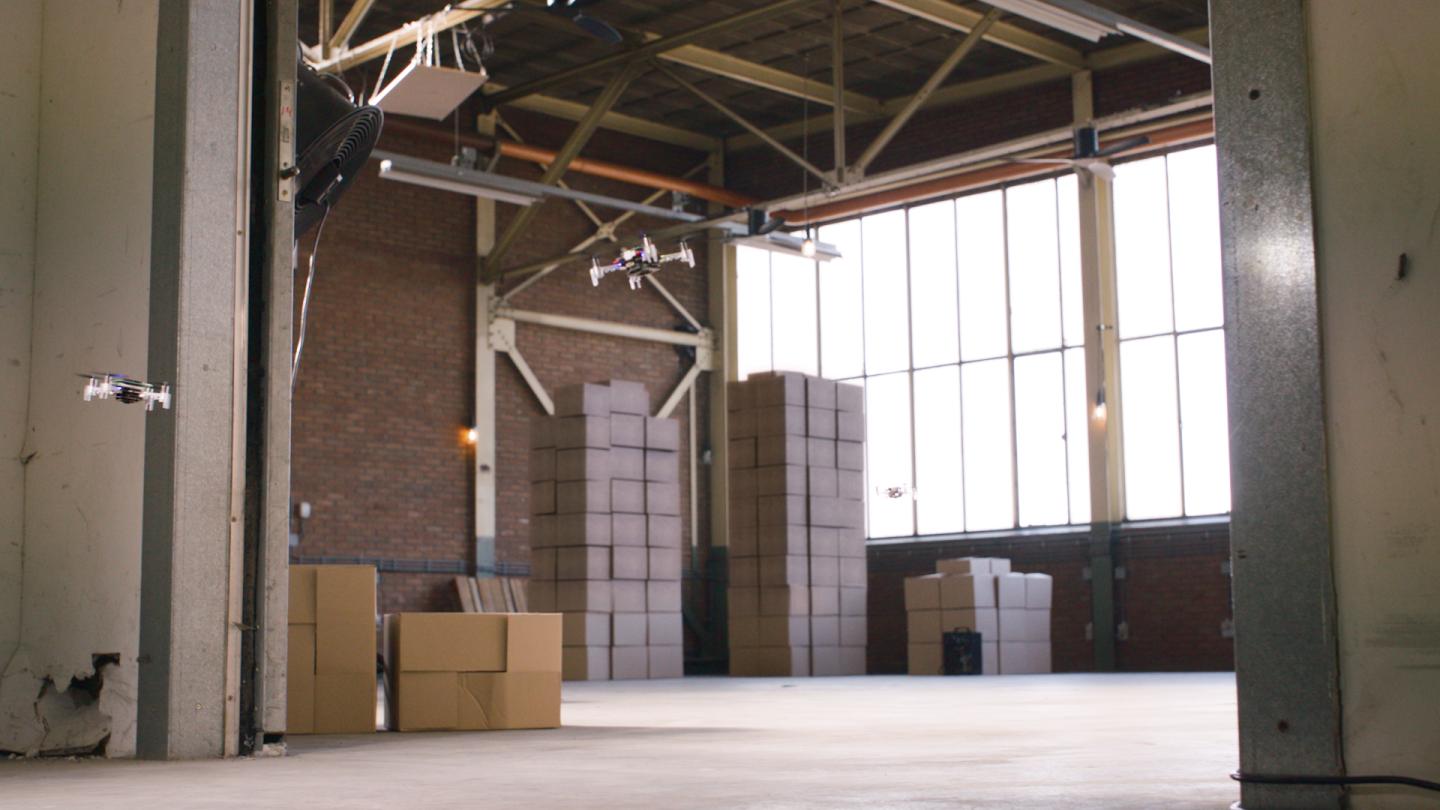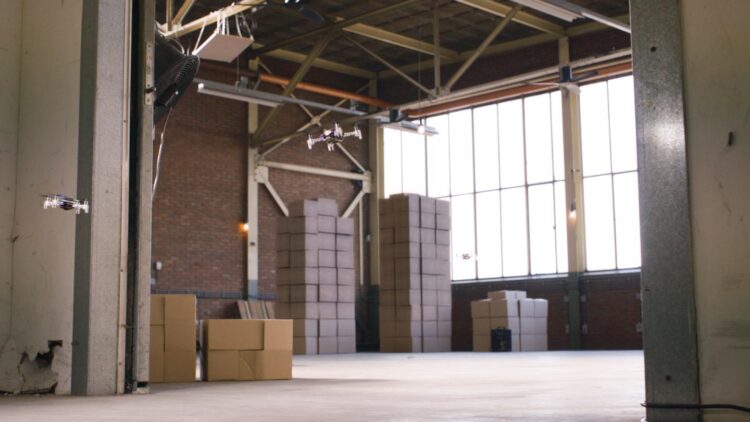
Credit: Mavlab/TU Delft
When there is a gas leak in a large building or at an industrial site, human firefighters currently need to go in with gas sensing instruments. Finding the gas leak may take considerable time, while they are risking their lives. Researchers from TU Delft (the Netherlands), University of Barcelona, and Harvard University have now developed the first swarm of tiny – and hence very safe – drones that can autonomously detect and localize gas sources in cluttered indoor environments.
The main challenge the researchers needed to solve was to design the Artificial Intelligence for this complex task that would fit in the tight computational and memory constraints of the tiny drones. They solved this challenge by means of bio-inspired navigation and search strategies. The scientific article has now been made public on the ArXiv article server, and it will be presented at the renowned IROS robotics conference later this year. The work forms an important step in the intelligence of small robots and will allow finding gas leaks more efficiently and without the risk of human lives in real-world environments.
Autonomous gas source localization
Autonomous gas source localization is a complex task. For one, artificial gas sensors are currently less capable than animal noses in detecting small amounts of gas and staying sensitive to quick changes in gas concentration. Moreover, the environment in which the gas spreads can be complex. Consequently, much of the research in this area has focused on single robots that search for a gas source in rather small, obstacle-free environments in which the source is easier to find.
Swarms of tiny drones
“We are convinced that swarms of tiny drones are a promising avenue for autonomous gas source localization”, says Guido de Croon, Full Professor at the Micro Air Vehicle laboratory of TU Delft. “The drones’ tiny size makes them very safe to any humans and property still in the building, while their flying capability will allow them to eventually search for the source in three dimensions. Moreover, their small size allows them to fly in narrow indoor areas. Finally, having a swarm of these drones allows them to localize a gas source quicker, while escaping local maxima of gas concentration in order to find the true source.”
However, these properties also make it very hard to instill the drones with the necessary artificial intelligence for autonomous gas source localization. The onboard sensing and processing is extremely limited, excluding the type of AI algorithms that make self-driving cars autonomous. Moreover, operating in a swarm brings its own challenges, since the drones need to be aware of each other for collision avoidance and collaboration.
Bio-inspired Artificial Intelligence
“Actually, in nature there are ample examples of successful navigation and odor source localization within strict resource constraints.”, says Bart Duisterhof, who performed the research for obtaining his MSc thesis at TU Delft. “Just think of how fruitflies with their tiny brains of ~100,000 neurons infallibly locate the bananas in your kitchen in the summer. They do this by elegantly combining simple behaviors such as flying upwind or orthogonally to the wind depending on whether they sense the odor. Although we could not directly copy these behaviors due to the absence of airflow sensors on our robots, we have instilled our robots with similarly simple behaviors to tackle the task.”
In particular, the tiny drones implement a new “bug” algorithm for their navigation, termed “Sniffy Bug”. As long as no drone has sensed any gas, the drones spread out as much as possible over the environment, while avoiding obstacles and each other. If one of the drones senses gas at its location, it communicates this to the others. From that point on, the drones will collaborate with each other to find the gas source as soon as possible. Specifically, the swarm then performs a search for maximal gas concentration with an algorithm termed “particle swarm optimization” (PSO), with each drone being a “particle”. This algorithm was originally modelled after the social behavior and motion of bird flocks. It has each drone moving based on its own perceived highest gas concentration location, the swarm’s highest location, and an inertia in its current moving direction. As a search strategy, PSO has the advantage that it only requires measuring the gas concentration, and not the gas concentration gradient or wind direction. Furthermore, it allows the swarm to ignore local maxima that may occur in complex environments.
The path to real-world applications
“This research shows that swarms of tiny drones can perform very complex tasks.”, adds Guido, “We hope that this work forms an inspiration for other robotics researchers to rethink the type of AI that is necessary for autonomous flight.”
The development of this type of technology to a fully functioning product still requires further work. For instance, the current work does not yet tackle moving in three dimensions to locate gas sources at a height. Furthermore, the robustness of navigation should also be improved before deploying the drones in a real emergency scenario.
However, the current work is very promising. The developed algorithms are not only useful for detecting gas leaks in buildings, but also for scientific missions such as detecting methane on Mars or economical use such as the early detection of diseases or pests in greenhouses.
###
More information
Scientific article:
Sniffy Bug: A Fully Autonomous Swarm of Gas-Seeking Nano Quadcopters in Cluttered Environments, by B.P. Duisterhof, S. Li, J. Burgués, V.J. Reddi, and G.C.H.E. de Croon, accepted at IEEE/RSJ International Conference on Intelligent Robots and Systems 2021 (IROS 2021). – Preprint available at the Arxiv: https:/
Video at: https:/
Video playlist: https:/
More information at: http://mavlab.
Media Contact
Guido de Croon
[email protected]
Original Source
https:/





